“We need to talk.” Nobody likes to hear those words from their spouse. Especially when it’s delivered in a grave tone as you rot on a couch in a grubby blankie, staring like a zombie while doomscrolling.
“Wut?” I said, very intelligently.
What came next was a compassionate but firm speech about how I was in dire need of an intervention. My attention span, my spouse said, was utterly shot to hell. They’d just asked my opinion about something happening on the TV show we were watching. I hadn’t heard them. At all. Apparently, they’d repeated the question three times. Instead, I’d been engrossed in… actually, I couldn’t tell you.
“You have a problem,” they said, tapping my phone. “You can’t put it down.”
I launched into an impassioned self-defense. A close friend was going through a tough time, and I was worried about them. My bestie was asking my opinion on a dicey work matter. Those texts could not wait! Plus, it was a busy week at work, and I was keeping an eye on something in Slack. And I’d only picked up my phone during our sacred viewing of Love is Blind to look up a factoid about the tea the show producers had kept hidden, and then I’d seen an ad for a new sunscreen and — oh.
“It’s not a ‘you’ problem,” my infinitely patient spouse said. “I do it, too. Which is why I think you should Brick yourself.”
For the second time that night, I uttered a very intelligent, “Wut?”
As it turns out, my spouse heard about Brick from a podcast and had been using it for months. It’s an app that ‘bricks’ distracting apps and their notifications. Similar to other screen-time apps, you can create modes that let you pick and choose which distracting apps to block. For example, a “deep work mode” that blocks all social media. But unlike other screen time apps, this one gets a bit nuclear.
Brick comes with a physical key — a small NFC-enabled square about the size of an AirPods case. You tap your phone to the key to brick it, and you must tap the device again to unbrick it. If you lose the key, you can’t unbrick your phone. The company gives you only five “emergency unbrick” codes to manually override blocked apps in a pinch. Once you use one, it’s gone. Forever. If you use the codes up and lose the key, well. You’ve got to factory-reset. There’s even a “strict mode” that prevents you from deleting all apps while your phone is bricked. As in, you won’t be able to bypass it by deleting and redownloading blocked apps.
My spouse had lost their Brick. Apparently, that’s why they hadn’t been on social media in weeks. They were adamant that my attention span — and therefore my life — would dramatically improve if I tried it too.
So I gave it an honest go. It went poorly.
The main problem is that Brick requires you to be intentional about being present. I was addicted to being omnipresent. I became so worried about losing the key — and therefore my connection to Knowing Things — that I carried it with me everywhere. When you carry the key with you, it becomes stupidly easy to just unbrick your phone whenever temptation or mild inconvenience strikes.
My failure was useful, though. It underscored everything my spouse said about how my attention span had eroded over the past five years.
Humbling as it was, I had to look at how I got here. As a caretaker, I’d gotten used to allowing every notification because I was afraid of missing an important one. As executor of my mother’s estate, I’d been trained to jump at every email and to pick up every unknown call because it could be a bank representative, an unpaid bill collector, or a long-lost friend wanting to know what happened. And, well, in journalism, you’re incentivized to pivot at a moment’s notice if news breaks. It’s hard to fully unplug when a small portion of your brain is always on call.
Despite the dopamine rush I get from answering notifications, it’s a bad way to live long-term. I love reading. I used to be able to devour A Song of Ice and Fire books in a single sitting. I was one of those dorks who read nearly 100 books a year. But in the last year, getting through a single chapter was a Herculean struggle. But where I noticed it most was while watching TV shows and movies.
At first, it started with recognizing an actor but not knowing from where. I’d reach for my phone, look them up, and go back to watching. Simple. But somewhere along the way, particularly while watching thrillers or horror movies, I became unable to handle the anxiety of not knowing what would happen next. The internet is glorious for that. Some people hate spoilers, but I devoured them. I started avoiding movie theaters, not just because they were expensive, but because my hands would itch with the urge to look things up. And once you pick up your phone, something else will grab your attention next.
It wasn’t until I saw Old Friends and John Proctor is the Villain that it hit me. In a Broadway theater, a grumpy usher will kick you out if you’re on your phone. (Or, Tony Award-winner Patti LuPone might snatch it from your hand.) The not-knowing was uncomfortable at first. But sitting with that discomfort also allowed me to feel delighted when moments of the shows surprised me. I remembered that not knowing isn’t always a portent of disaster. It can be a good thing.
Maybe I’d failed with Brick because of my tendency to optimize for every scenario. Right off the bat, I’d created a Work mode, a Writing mode, a Reading mode, a TV mode, a Fitness mode, and so on and so forth. Who in their right mind is going to remember to tap a device every time they switch gears? I put maybe two hours of work into selecting which apps to block for each without knowing what I actually needed. That only frustrated me when I required something from my phone. Ultimately, I put myself in a situation where I couldn’t possibly succeed. But what if I just used Brick for one scenario: Watching TV.
I remembered that not knowing isn’t always a portent of disaster. It can be a good thing.
I’ve since edited my Brick’s TV mode. When enabled, the only apps I can use are Messages and utilities like the Clock, Calls, or the Wallet app. People can reach me in real emergencies, but once a show starts, I now put my phone face down on the table and take off my smartwatches. I’m trying a thing where, if I have an insatiable burning need to know something during an episode, I write it down on a memo pad. So far, I’ve learned the world doesn’t end if I am late to respond — even if people, usually other chronically online friends, get tetchy with me.
My attention span hasn’t been fully rehabilitated. My spouse and I are currently rewatching Law and Order SVU, and every time there’s a cameo, I nearly lose my mind trying to figure out who it is. But I miss fewer plot points. I laugh more because I’m not missing Ice-T’s infamous zingers. I’m still struggling with longer movies and prestige shows, but I’ve started reading more easily again. I can’t prove these two things are related, but it feels like they are.
I don’t know that I’ll ever find the perfect balance between being connected and disconnected. Brick still doesn’t work for me in every scenario. I don’t think this is a solution that’ll work for everyone in the same boat. But this experiment has been a helpful reminder that you don’t always have to go big and fix everything at once. Sometimes, all it takes is a tweak to get a small win.
Now, if you’ll excuse me, I have to go rescue my Brick key from my cat. I like a little peace, but I’m not ready to lose an emergency unbrick code just yet.




















